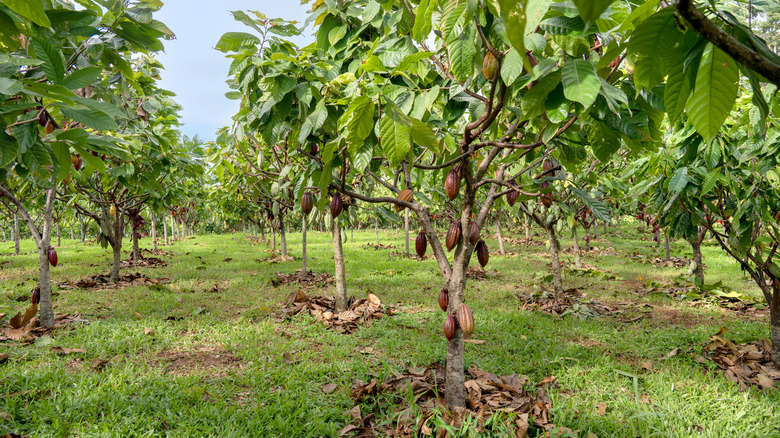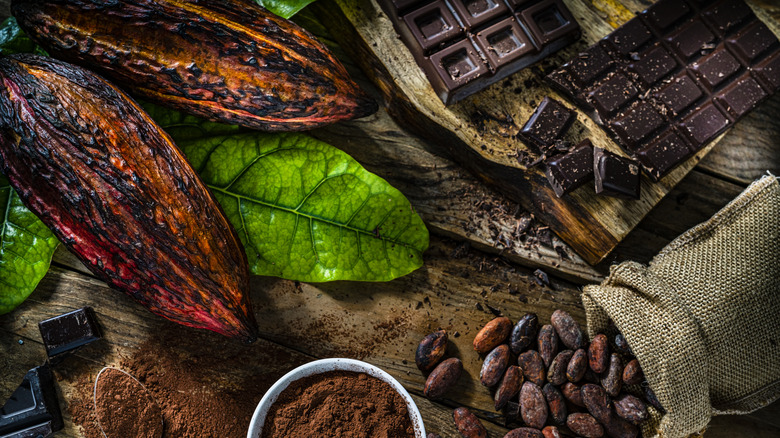Why Climate Change Could Force A Non-Chocolate Candy Trend
Chocolate is always in high demand. Even as inflation has changed the way Americans eat, chocolate products have remained as popular as ever — more so, as the industry has shown steady growth. The National Confectioners Association's annual State of Treating report notes that chocolate sales rose 5.8% in 2023. In fact, sales have grown every year since the NCA released its first State of Treating report in 2020, weathering a global pandemic, supply chain crisis, and volatile economic trends.
But these numbers do not tell the whole story. Yes, chocolate sales have continued to rise, but they have been considerably outpaced by sales of non-chocolate candy. The NCA reports that non-chocolate candy sales rose 12.1% in 2023, more than double the rate of chocolate. At the same time, chocolate sales showed significantly less growth in 2023 compared to the previous two years, which both saw growth of over 9%.
These figures point to a growing trend in the confectionary business. Non-chocolate candies are surging to the front of the industry, but it's not because we've lost our taste for chocolate. The truth is, we may not have chocolate chips on store shelves for much longer because cacao, the primary ingredient in chocolate, is facing a major threat due to climate change. Cacao harvests are dwindling, and with the crop's future in question, the world will need to search elsewhere to satisfy its sweet tooth.
Climate change is wreaking havoc on cacao farms
Cacao is one of the most vulnerable crops to climate change. The trees can only grow within 20 degrees of the equator, as they require a warm, tropical climate. The heart of the modern cacao trade is West Africa, with Ivory Coast, the country that produces the most cocoa in the world, and its neighbor, Ghana, accounting for more than half of the total global supply. Both nations have faced extreme climate conditions in recent years, swinging from devastating drought to torrential rain.
West Africa recorded record-high temperatures in 2023, but it's not actually the heat that harms cacao crops. Higher temperatures cause the water in soil and plants to evaporate, throwing the cycle into imbalance. Ivory Coast and Ghana have been gripped by drought, and what rain they have gotten has been far from helpful. In December of 2023, torrential rains more than double the 30-year average for West African winters brought a new nightmare to cacao farmers. The excessive moisture gave rise to a fungal disease that rots cocoa beans.
At the same time, cacao production itself has exacerbated climate change. Cacao farms are a major force behind deforestation, sometimes clearing trees illegally to expand their farmland. Deforestation further contributes to drought conditions and threatens biodiversity, which could make cacao more vulnerable to pests. To this extent, the demise of chocolate is a self-fulfilling prophecy.
Facing a chocolate shortage
The impact of climate change on West Africa has made chocolate scarcer and more expensive. CNN reports an 11.6% rise in chocolate prices across 2023, forcing chocolate in the direction of a luxury good rather than an everyday treat. Consumers have responded by eating less chocolate and more non-chocolate confections. Even though the NCA reported a 5.8% growth in chocolate sales, the total units of chocolate sold dropped by almost as much, revealing that the growth was entirely due to higher prices, not higher consumption.
In response, chocolate companies have sought to diversify their product lines, adding more non-chocolate options. Hershey's announced plans to increase gummy candy production by 50% in 2024 while others have sought to cut costs, which could mean making chocolate with a lower cocoa percentage, or scaling back production altogether in favor of non-chocolate alternatives.
The future of cacao farms looks bleak at the moment. The National Oceanic and Atmospheric Administration predicts that as much as 89.5% of the land used to cultivate cacao could become unsuitable by 2050. This does not mean that cacao itself will go extinct though, as some have suggested. There are still strings of wild cacao, particularly in South America, where the plant originated. Meanwhile, chocolate producers like Hershey's and Mars have been working to develop genetically-modified cacao trees that are more resistant to extreme climate conditions. Chocolate isn't done for, but its days of dominating the candy world may be nearing an end.


